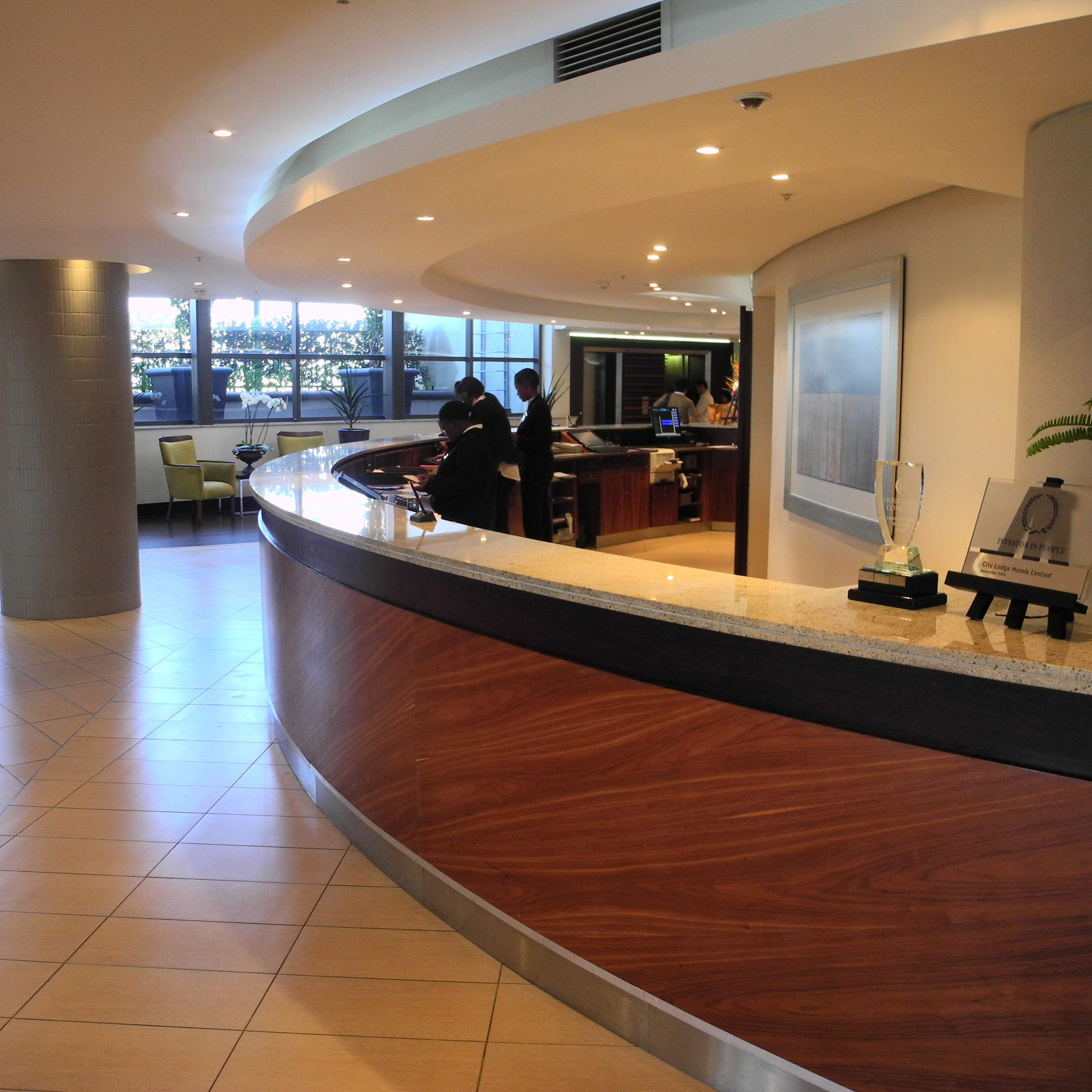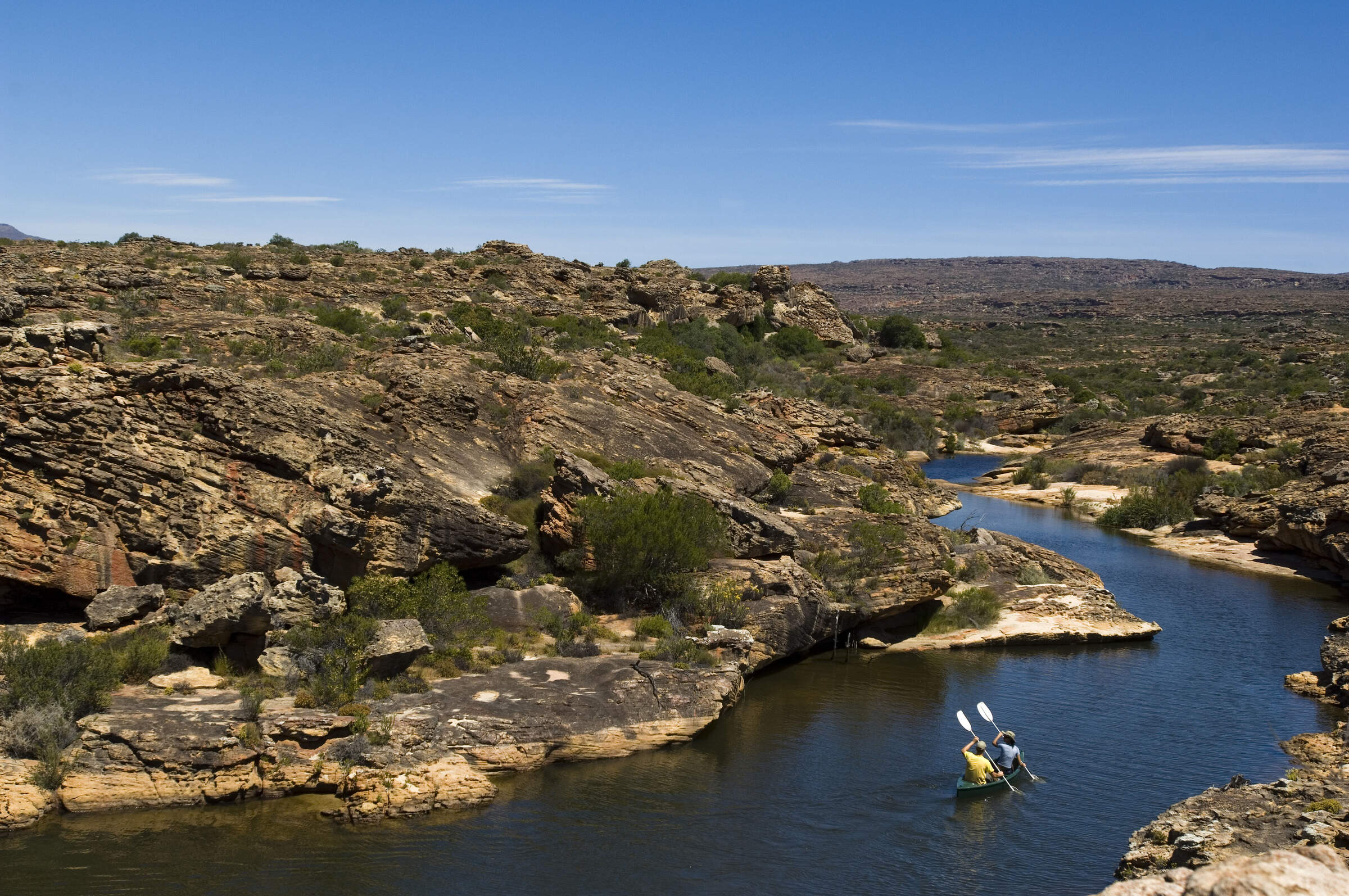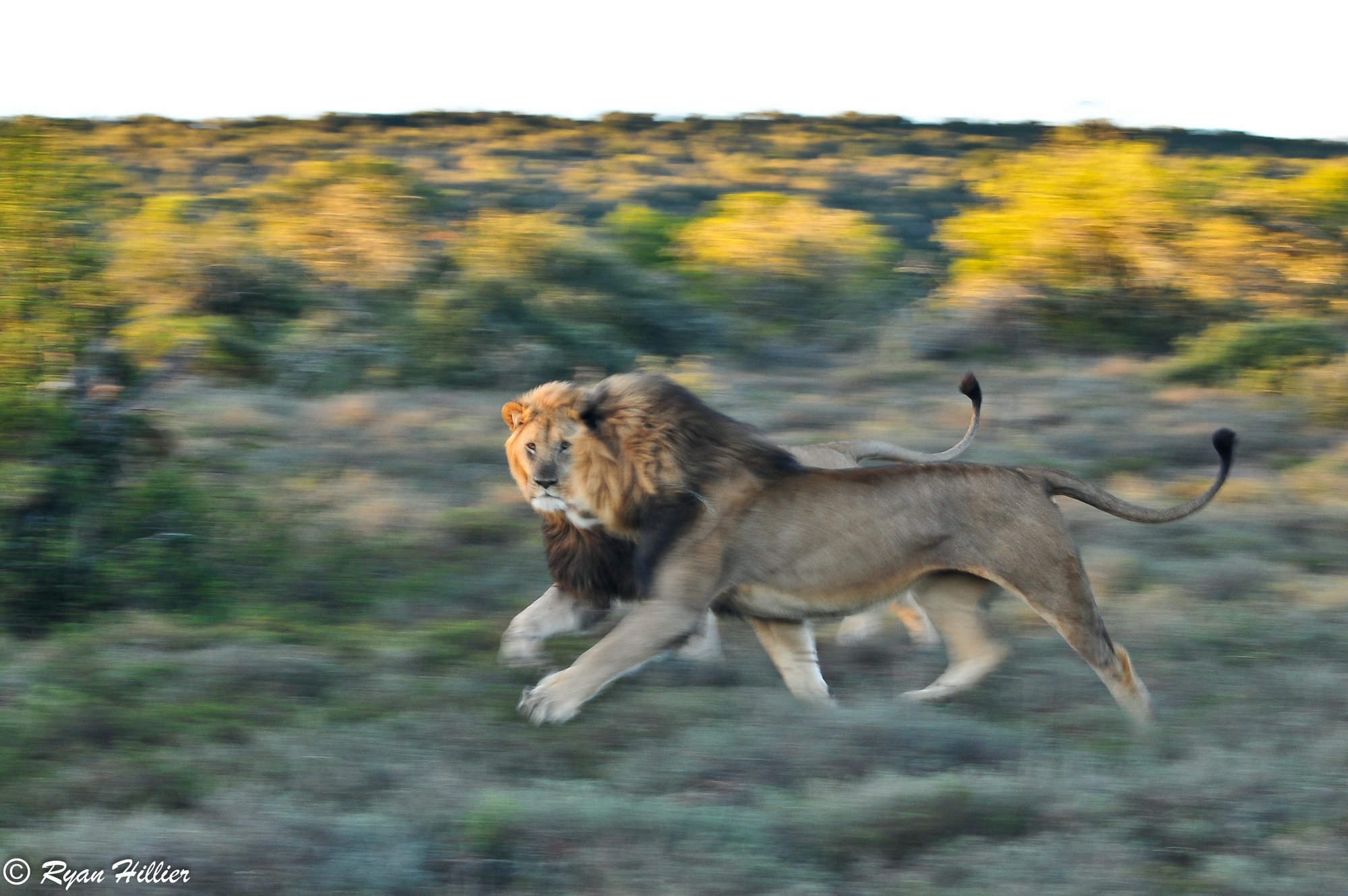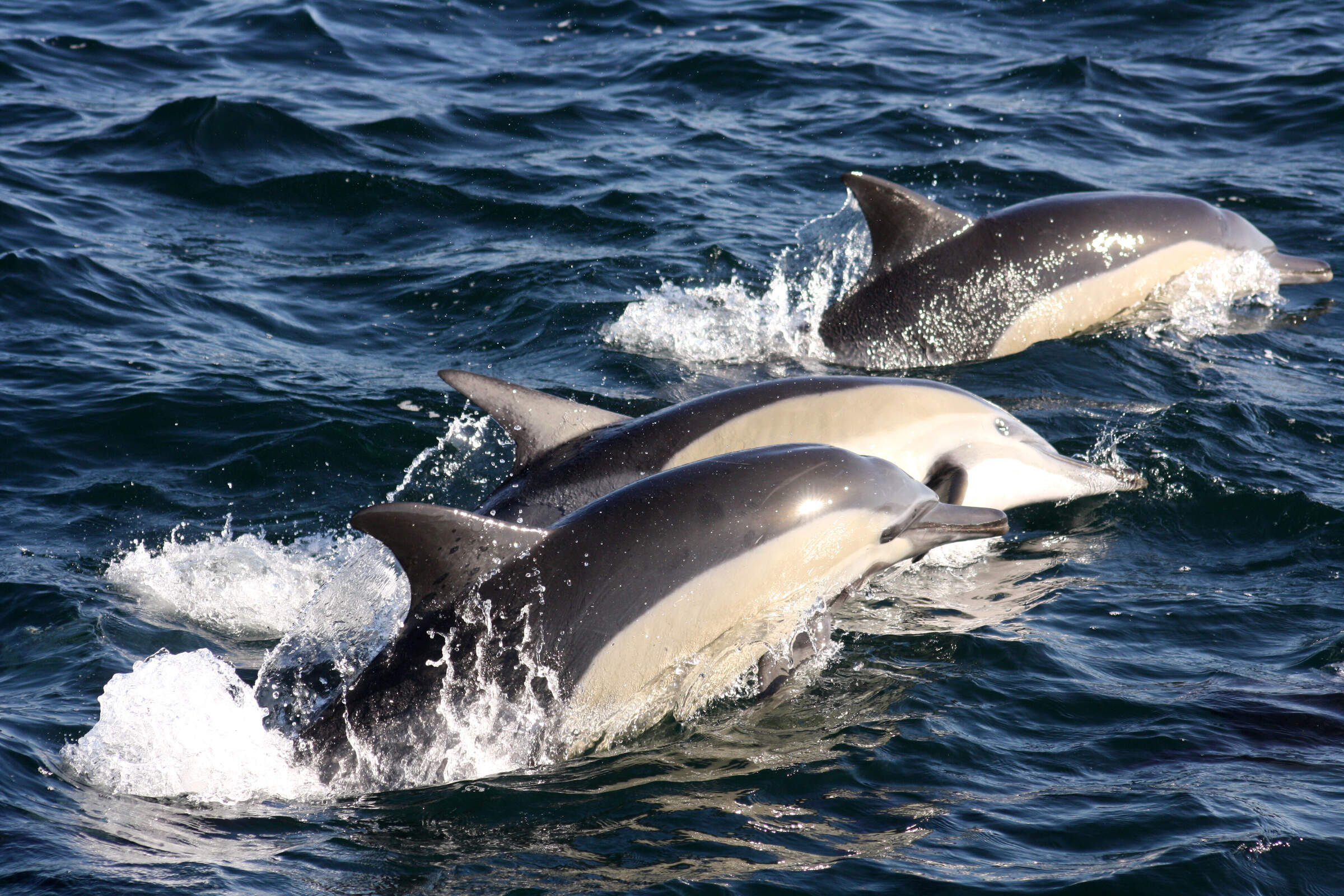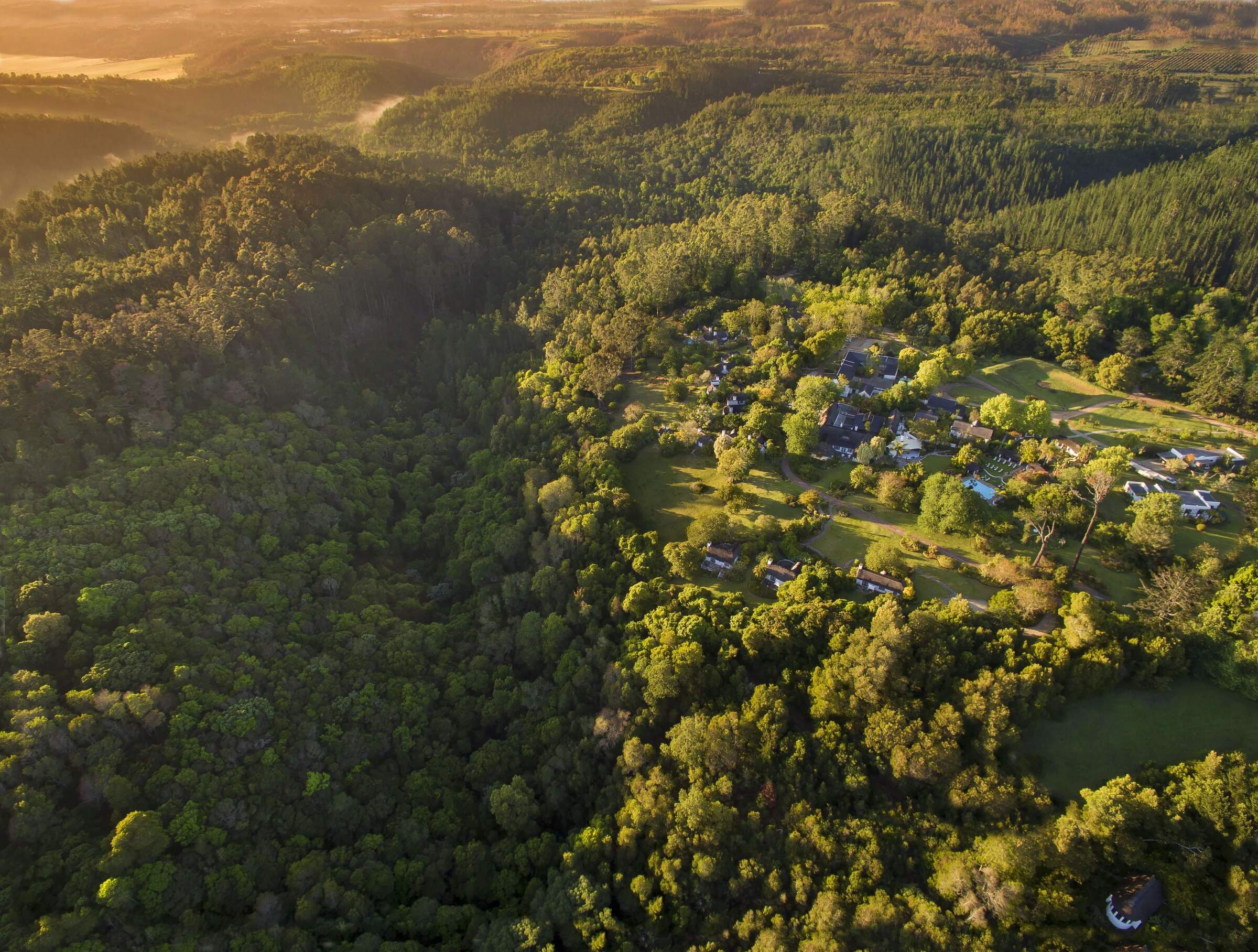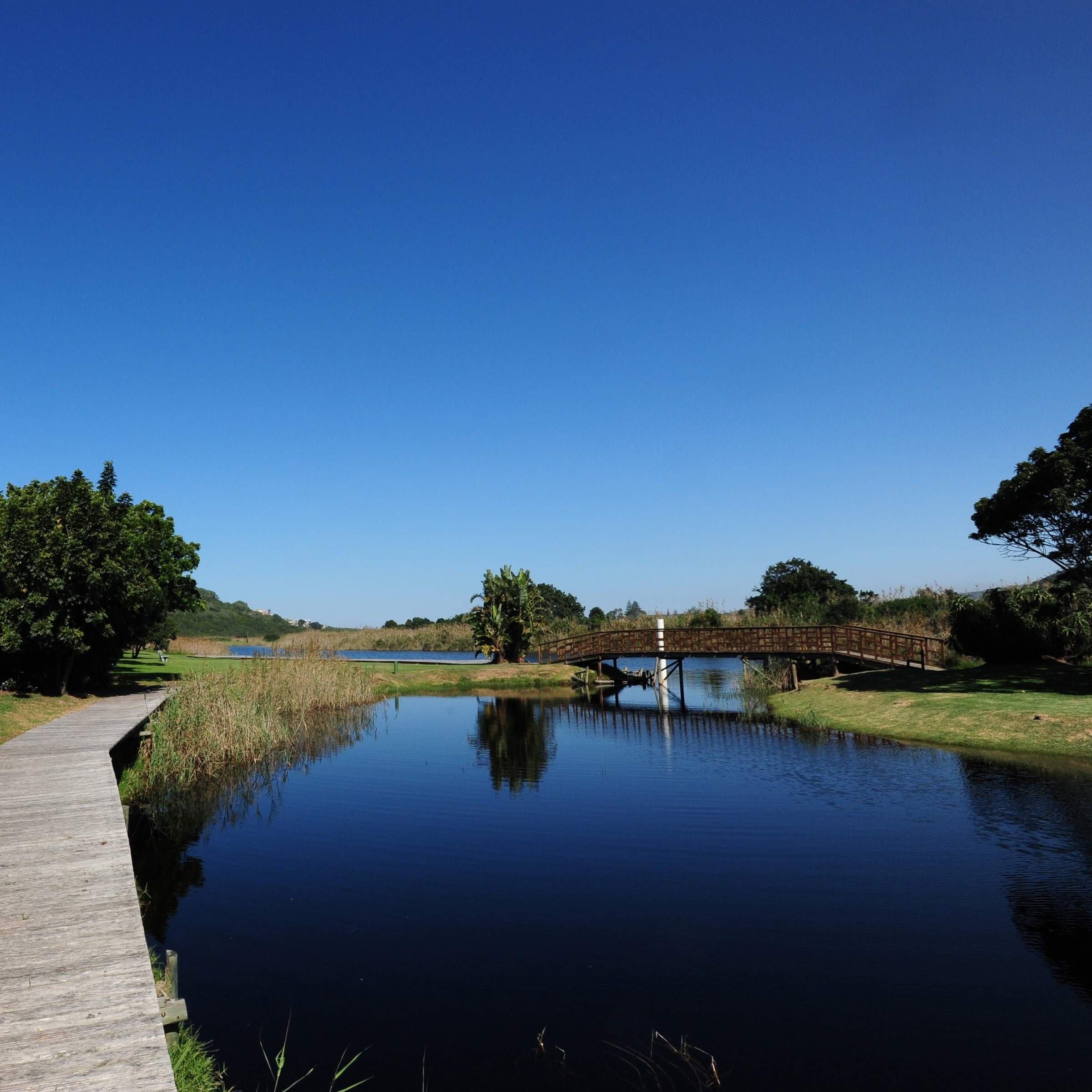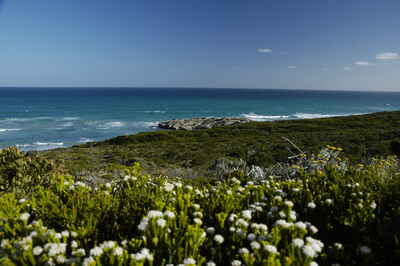
De Hoop has a great diversity of ecosystems...
...which visitors can explore by foot quite safely.
Discover De Hoop’s beautiful coastal environment...
...where spectacular sand dunes rise up high.
You can join guided walks to learn about the reserve’s marine life.
De Hoop Opstal is the only place to stay within in the park.
De Hoop is a place that’s worth visiting.
De Hoop Nature Reserve
De Hoop Nature Reserve
De Hoop’s super-sized sand dunes, rich rock-pools and floral fynbos hills offer super hiking, birding and phenomenal coastal whale-watching.
De Hoop Nature Reserve has a remote, faraway feel, and yet part of its pleasure is in its ease of access. Only 60km south of Swellendam, this nature reserve is a joyful addition to any road trip, made magical by its diversity of landscape and wildlife, and the ability to stretch your legs and explore on foot.
Covering just 340km², it’s a relatively small park but it punches well above its weight in variety and opportunity. The rolling fynbos hillsides are punctuated with wide antelope-filled plains, abounding with bontebok, Cape mountain zebra, eland and surprisingly swift leopard tortoises. Whilst a 16km-long lake, skirted by a superb walking trail, is home to a great range of water and wetland birds - flamingos, spoonbills, pelicans, white-fronted cormorants and black-necked grebes – the Potberg Mountain area is home to the region’s only remaining breeding colony of Cape vultures and the spectacular sand dunes that rise up from the coast are patrolled by African harrier-hawks. De Hoop is certainly one of South Africa’s most important birding areas.
In the waters beyond the rugged coast, the marine environment is protected with UNESCO Heritage Site status as one of the world’s most important nurseries for the endangered Southern Right whale. From June-November, these whales come so close to the shoreline that you can relax on the towering sand dunes and watch the spectacle as these incredible creatures calve, blow and breach - unquestionably one of the world’s best land-based whale-watching areas, and blissfully quiet.
And with little dangerous game, walking is actively encouraged on the De Hoop Reserve, and clearly marked trails allow you to guide yourself around the diverse landscapes, passing relaxed antelope and ostrich, alternatively, guided marine walks to explore the dunes, waterline caves and gentle terraces of enormous inter-tidal rock pools, eco boat trips and even stargazing sessions are all available.
De Hoop may be little known and low key, but it’s a real gem on a Garden Route road trip.

Trips visiting De Hoop Reserve
Just ideas, we'll always tailor-make a trip for you
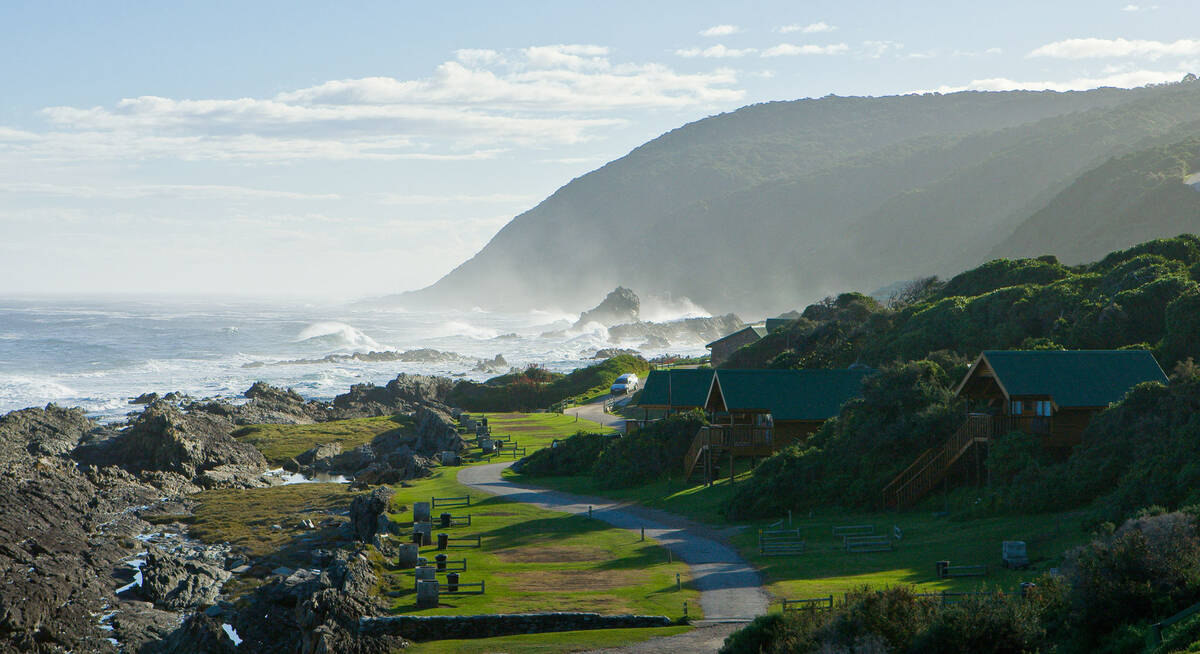
Bontebok Self-drive Safari
12 days • 5 locations
CAPE TOWN AIRPORT TO PORT ELIZABETH AIRPORT
This varied and great-value self-drive trip visits Cape Town, the Winelands and diverse sections of the Garden Route, staying at great places with real local character. It’s ideal for active couples and families who want to explore the Cape’s stunning locations.
US$1,760 - US$1,900 per person
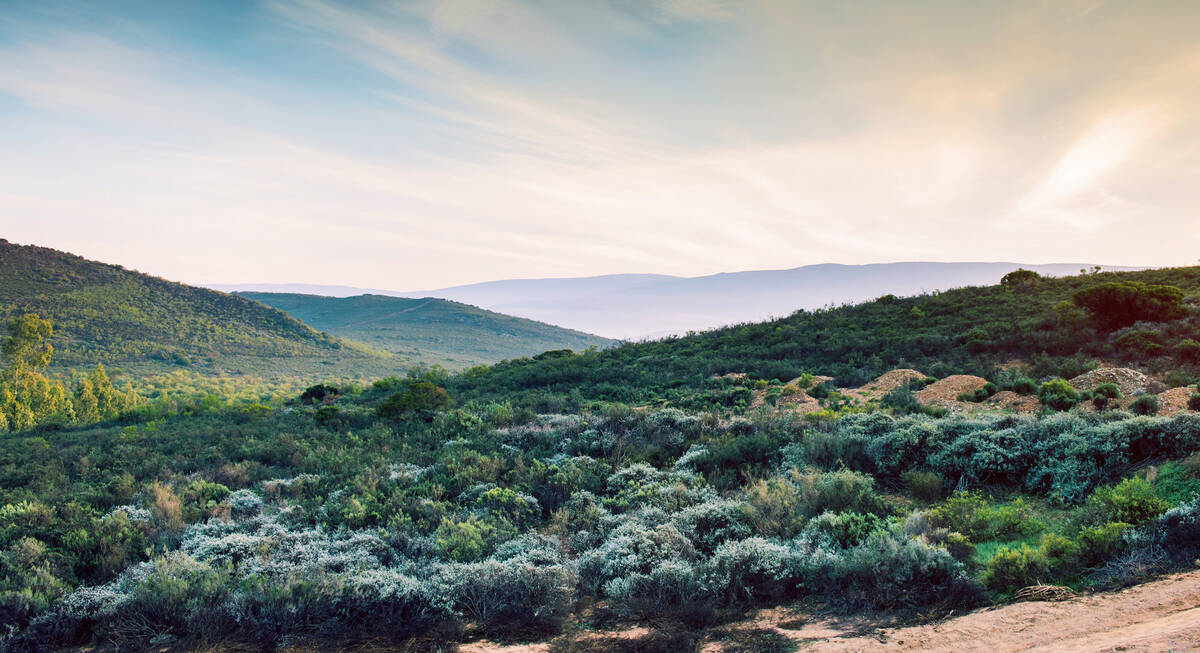
Cape Genet Self-drive Safari
20 days • 8 locations
CAPE TOWN AIRPORT TO CAPE TOWN AIRPORT
Enjoy fine-dining in Cape Town, whale-watching in Hermanus, and a range of walking and water-based activities throughout De Hoop’s Nature Reserve, the Klein Karoo and Plettenberg. This relaxed self-driven safari concludes with stays in The Winelands and Namaqualand.
US$3,580 - US$4,290 per person
Most recent reviews of our trips to De Hoop Reserve
Click below to browse all 28 reviews from De Hoop Nature Reserve. All from our travellers; all are in full & unedited.
Arrived 31 Oct 2024, 28 nights
"Our Nov 2024 trip"
Overall rating: Excellent
Arrived 15 Dec 2023, 23 nights
"My Dec 2023 trip"
Overall rating: Excellent
Arrived 4 Apr 2023, 20 nights
"My Apr 2023 trip"
Overall rating: Excellent
Arrived 1 Nov 2022, 23 nights
"My Nov 2022 trip Botswana, Zimbabwe & South Africa"
Overall rating: Excellent
Arrived 26 Jan 2022, 27 nights
"Escaping the UK Winter, embracing PCR tests to visit"
Overall rating: Excellent
Arrived 14 Feb 2020, 14 nights
"My Feb 2020 trip"
Overall rating: Excellent
Arrived 27 Oct 2019, 24 nights
"A memorable and wonderful three weeks"
Overall rating: Excellent
Arrived 22 Jun 2019, 22 nights
"Family trip to SA in June/July 2019"
Overall rating: Excellent
Arrived 4 Apr 2019, 21 nights
"Hammerton Family Adventure"
Overall rating: Excellent
Arrived 8 Apr 2018, 11 nights
"A wonderful trip which was well organised. "
Overall rating: Excellent
Where to stay in De Hoop Reserve
Our suggestions for places to stay in De Hoop Nature Reserve
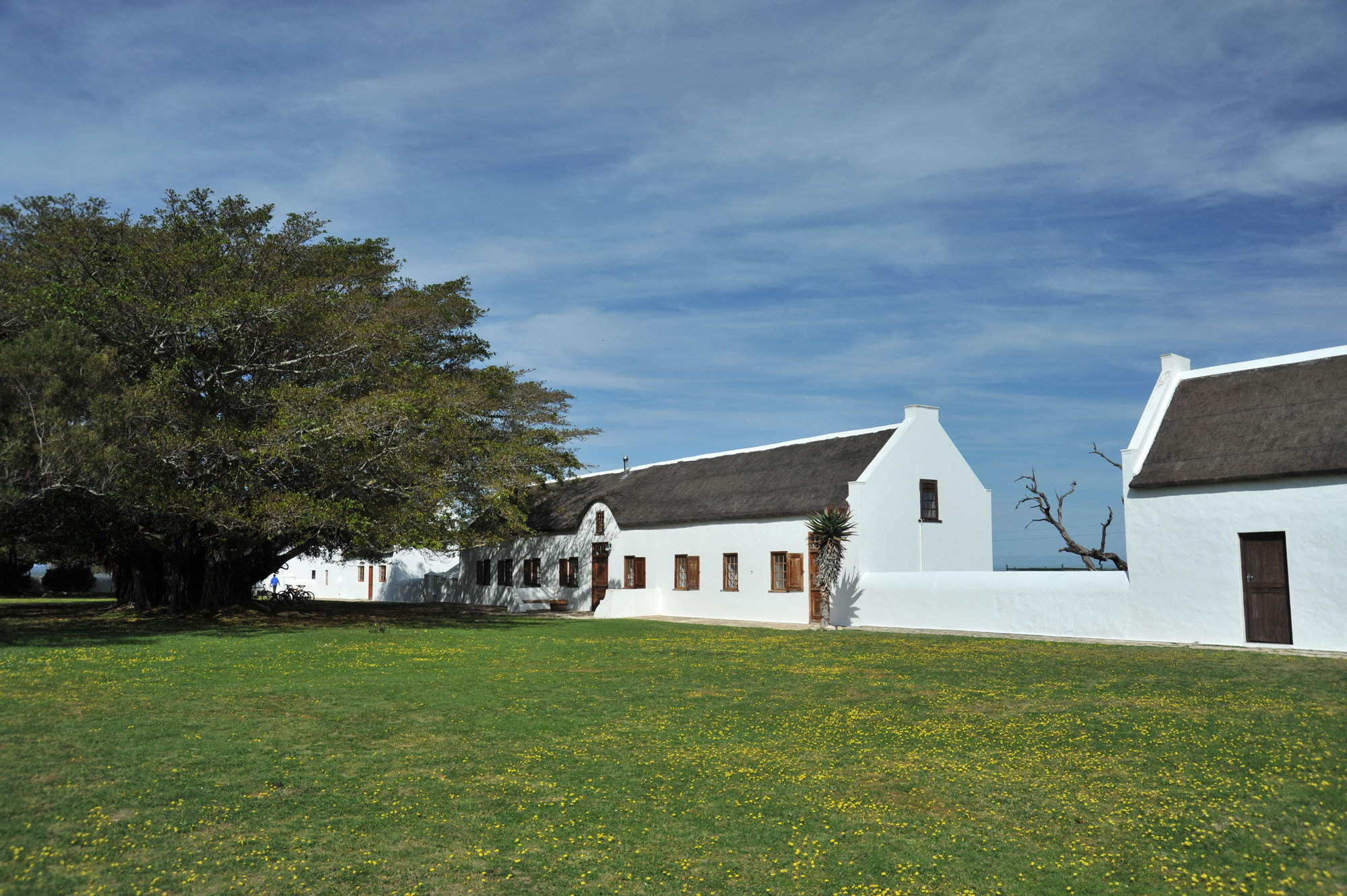
The Opstal
The Opstal forms part of the central hub of the De Hoop Nature Reserve and has a range of rooms and cottages to suit most people
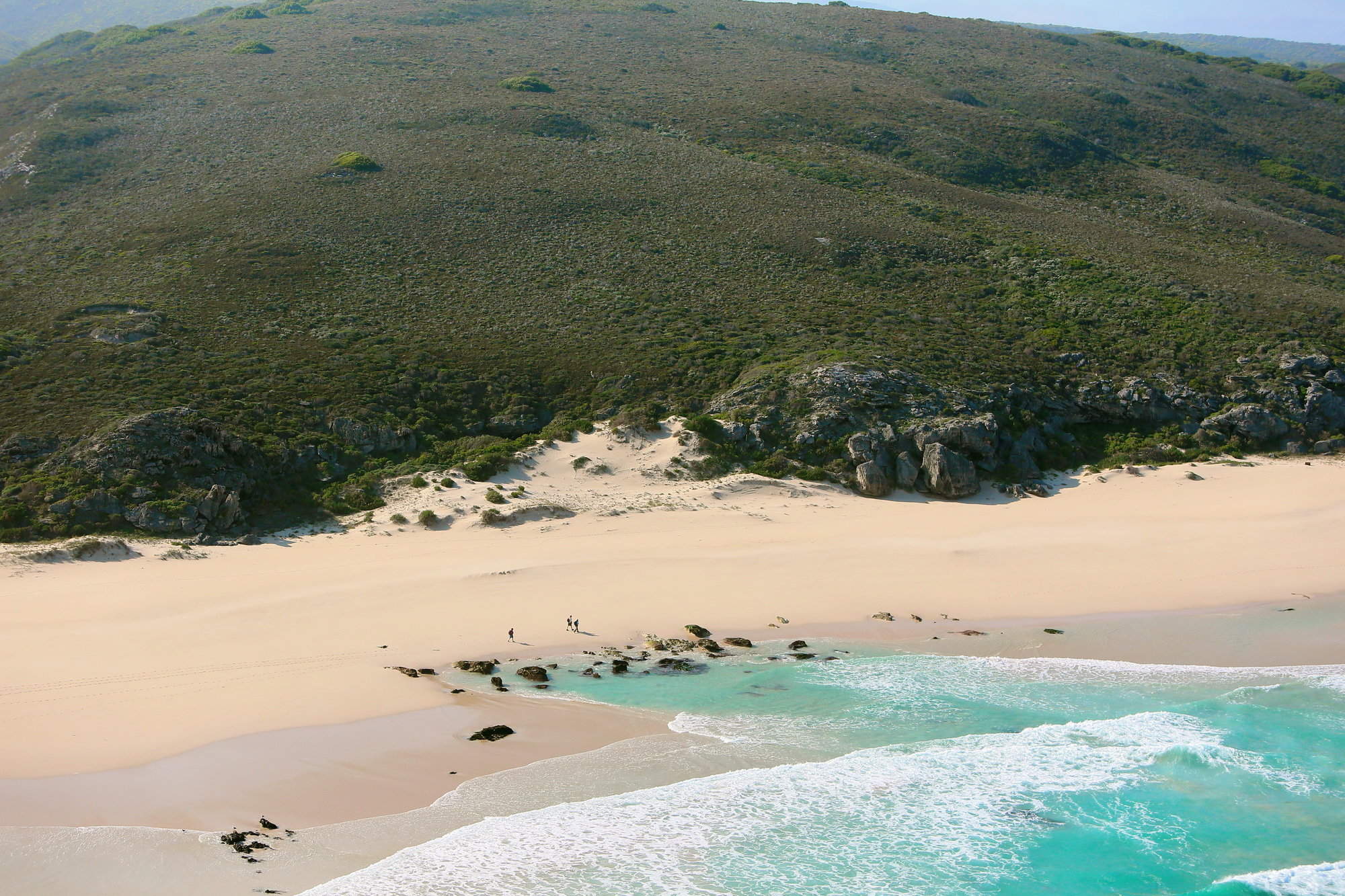
Lekkerwater Beach Lodge
Overlooking a stunning beach and the Indian Ocean, Lekkerwater Beach Lodge is a modern camp with very comfortable rooms in a little known yet beautiful reserve.
Our travellers’ wildlife sightings in De Hoop Reserve
This is their success for sightings in De Hoop Nature Reserve. Click on a species for more detail. How we work this out.

100% success

80% success

0% success
When to go to De Hoop Nature Reserve
Our month by month guide: What it's like to visit De Hoop Reserve in South Africa
Jan
Feb
Mar
Apr
May
Jun
Jul
Aug
Sep
Oct
Nov
Dec
South Africa in January
January is considered one of the best months to travel. In Cape Town the weather is hot and generally dry. The Garden Route is also excellent at this time of the year but has a more temperate climate, with slightly lower temperatures and rain can fall at any time of the year. In the Kgalagadi temperatures often top 40°C and short, sharp thunderstorms are also fairly frequent. Wildlife tends to disperse, although birding is excellent.
As this is the high season in the Cape there are numerous events, festivals and outdoor activities to attract visitors. Accommodation books up quickly and it may be necessary to book at least a year in advance. Reservations will often be needed for restaurants and visitor attractions too.
- Hot, largely dry days with clear skies – except on Garden Route
- Wildlife disperses in the Kalahari but birding excellent
- Events, festivals and outdoor activities staged for the high season
- The high season in the Cape, accommodation can cost up to 50% more
- Pre-booking of activities & attractions is essential
Our view
Fantastic: the very best time to visit
Weather in January
South Africa in February
In February conditions are largely the same as in January, although temperatures can be slightly higher, especially in the interior. The wind in Cape Town starts to ease off. Although the Garden Route can experience some rain, the days are pleasantly warm and largely dry.
The Kgalagadi remains very hot, but the birding is still excellent. Wildlife viewing can be tricky especially if there has been some rain, as the resulting long grass can obscure the animals.
For visitors it’s still the high season, but with the local school holidays over and residents back at work, it is less busy than December and January. Accommodation costs remain high and it’s still advisable to pre-book certain activities and restaurants.
- Hot, largely dry days with little cloud
- Wind starts easing in Cape Town
- Slightly less busy than December & January
- Accommodation costs remain high, activities still best pre-booked
Our view
Fantastic: the very best time to visit
Weather in February
South Africa in March
March is still a very good time to visit. Conditions remain dry and very warm in Cape Town, although temperatures start dropping off towards the end of the month. The wind has usually died right down.
The Kalahari remains very hot and in years of good rains vegetation is at its most lush – making wildlife viewing tricky.
Typically, the crowds dwindle, but it can get very busy if Easter falls in March. It is also worth bearing in mind that during major events in March, including the Cape Town Cycle Tour, Cape Epic Mountain Bike Tour, The Cape Town Carnival and the International Jazz Festival, accommodation can get very full.
Attractions remain busy but booking is less essential.
- Temperatures start falling towards the end of the month
- Cape Town hosts a number of world class sport and cultural events
- Wildlife in the Kgalagadi disperses, game viewing more challenging
- Crowds diminish as the high season comes to an end
- Accommodation can get busy during major events
Our view
Fantastic: the very best time to visit
Weather in March
South Africa in April
April is South Africa’s “shoulder” season and is often the most pleasant. Not too hot, not too cold, some rain but not masses. In Cape Town and along the Garden Route days are usually sunny, warm, windless and largely dry, although in Cape Town the chance of rain increases from the end of the month.
In the Kgalagadi the rainy season is typically over and migratory birds are starting to make their journey back up North. Vegetation remains lush but wildlife viewing starts picking up towards the end of the month.
The region is still relatively busy (especially of its still Easter) but it gets quieter towards the end of the month thus availability improves. Accommodation rates start to decrease, and it becomes less important to book restaurants and attractions in advance.
- Temperatures still warm and very pleasant, with little wind.
- Rain starts easing in the Kalahari and migratory birds start to depart
- Less busy, especially towards the end of the month - busy over Easter
- Accommodation frees up and prices start to come down
Our view
A very good time to visit
Weather in April
South Africa in May
May marks the start of the dry season in the Kgalagadi. Days are warm and dry with almost zero rainfall. Night-time/early-morning temperatures can drop towards 0°C. Wildlife viewing is at its peak as animals concentrate around the few remaining water sources.
Days can still be warm and sunny in Cape Town and on the Garden Route, but the weather becomes a lot more variable. May heralds the start of the rainy season in Cape Town and the winelands. Night-time temperatures rarely drop below 10 degrees in the coastal areas.
With far fewer tourists, accommodation prices are at their lowest. There is rarely any need to pre-book activities, but reservations are still advisable at some of the top restaurants.
- Higher chance of rain in Cape Town & the Winelands
- Day time temperatures drop significantly
- Wildlife viewing peaks in the Kgalagadi
- Low season so rarely busy & very few crowds
- Low season rates at the hotels & lodges
Our view
A good time to visit, with pros & cons
Weather in May
South Africa in June
Winter is now in full swing. Maximum temperatures in Cape Town rarely reach 20°C and the rainy season is well under way. Outdoor activities therefore become limited, but a number of high-quality indoor events are organised.
The Garden Route has, in general milder weather and less rain than Cape Town.
June sees the arrival of the first whales which migrate to the South African coastline to give birth.
In the Kgalagadi, daytime temperatures are warm but nights and early mornings are bitterly cold. Wildlife viewing is excellent as animals are drawn to the few remaining permanent water points.
Overall tourist numbers are at their lowest, as are the costs of flights and accommodation.
- Cold & wet weather in Cape Town, Kgalagadi warm days but cold at night
- One of the best months for wildlife viewing in the Kgalagadi
- Whales start arriving to have their calves
- Low visitor numbers & no crowds
- Accommodation & flight prices remain low
Our view
A good time to visit, with pros & cons
Weather in June
South Africa in July
The winter weather continues with very cold nights and early mornings in the Kgalagadi and virtually no rainfall. Vegetation here is really thinning out now and water even more scarce – so wildlife is easy to spot.
Despite the winter and local school holidays, Cape Town remains a great place to visit. On a wet and cold day, the Two Oceans Aquarium, Zeitz Mocca (art museum) and the Cape Town Comedy Club all make for great days out, as does a trip to the wine country or the annual Oyster Festival at Knysna.
By mid-July most of the whales have arrived to give birth. Hermanus is the best place to see them.
At the height of the low season, so accommodation and flight prices remain low.
- Generally cold & wet in the Cape, but good quality indoor events
- Very good wildlife viewing in the Kgalagadi
- Oyster festival in Knysna
- Local school holidays can make places a little busier than usual
- Accommodation and flight prices remain low
Our view
A good time to visit, with pros & cons
Weather in July
South Africa in August
While August experiences mostly wintry weather it does mark the very beginning of spring with temperatures starting to rise. Visitors are drawn to the West Coast and Namaqualand to see the wildflowers, which start blooming in late August and can be seen until mid-September. Whales are still in abundance now too.
The Kgalagadi is now very dry and wildlife vieiwng is still good. Temperatures start climbing towards the end of the month.
Despite the weather , visitor numbers can be high as the northern hemisphere schools close for their summer holidays. It may be a good idea to book certain attractions and restaurants in advance.
Simlarly, although accommodation prices are still low, flight prices can be a little higher than in previous months.
- Temperatures start rising – but still potential for cold & wet weather
- Wildflowers on the West Coast & in Namaqualand
- Good wildlife viewing in the Kgalagadi
- Whales continue to attract visitors
- Can get busy due to northern hemisphere school summer holidays
Our view
A good time to visit, with pros & cons
Weather in August
South Africa in September
Good wildlife viewing in the Kgalagadi continues and daytime temperatures increase quite dramatically. Mornings and evenings are still on the chilly side, but not as cold as they are in June, July and August.
The 1st of September is officially the start of spring in Cape Town. Days become warmer but not quite warm enough to enjoy the city’s beautiful beaches. Venues all over Cape Town play host to various artists during the Cape Town Fringe Festival.
Rainy days are fewer, but night times can still get chilly. Many hotels are still charging low season rates making September great value for money.
Elsewhere, Hermanus hosts the popular annual Whale Festival, and in the West of the Cape, wildflowers continue to bloom until the middle of the month.
- The start of spring; temperatures start rising
- Whale festival in Hermanus
- Cape Town Fringe Ferstival attracts a wide range of artists
- Wildflowers blooming well until the middle of the month
- Good wildlife viewing continues in the Kgalagadi
Our view
A very good time to visit
Weather in September
South Africa in October
The weather starts warming up nicely, Cape Town experiences pleasant days, with much less rain, nights can still be quite cool, but not cold. Some days are now warm enough to enjoy the beach. This is one of the best months to visit the Cape Region.
October is one of the hottest months in the Kalahari. Water remains very scarce, so the wildlife viewing is still very good. Towards the end of the month the odd spectacular thunderstorm is possible with much lightning and thunder. Migratory birds start to arrive, and resident species gear up for the breeding season.
The whales are still present with Hermanus and False Bay the best places to see them.
- Days start warming up; fewer rainy days in Cape Town
- Very hot in the Kalahari – thunderstorms season starts
- Migratory birds start arriving & resident birds start breeding
- Whale watching still excellent in Hermanus and False Bay areas
- Start of the high season, getting busy and accommodation prices rise
Our view
A very good time to visit
Weather in October
South Africa in November
By November Cape Town is experiencing summer conditions with hot, clear days and warm, pleasant evenings. It’s a great month to enjoy the beaches before the peak holiday season in December. There are no real downsides to visiting in November and you may even get a few accommodation specials before prices go up for the festive season. Kirstenbosch Botanical Gardens begins their summer outdoor concerts with local and international artists performing.
The Kgalagadi remains hot but thunderstorms are a bit more regular. With the rains, water sources become more plentiful and wildlife disperses but this is when herbivores such as Springbok start lambing. Photography improves as conditions become less hazy.
This is the last month for regular whale sightings – they tend to migrate back down south by early December.
- Summer now in full swing, with temperatures often reaching 30°C
- Rainy days scarce; evenings warm & very pleasant
- Antelope start lambing in the Kgalagadi; wildlife generally dispersed
- Last month for regular whale sightings
- Good time to visit Cape Town before the peak holiday season
Our view
Fantastic: the very best time to visit
Weather in November
South Africa in December
December is usually Cape Town’s hottest month when temperatures frequently breach 30°C. You can expect hot and cloudless days, and almost no rain but December does see the occasional very windy day.
The Kalahari is still hot, but temperatures are not quite as high as previous months. With the rainfall the bush transforms into various shades of green. Wildlife disperses as water become more widely available.
The Garden Route enjoys warm to hot days with rain at any time but usually not over an extended period.
Mid to late December becomes incredibly busy with concerts, festivals and various outdoor activities in Cape Town. Hotel prices rise, tourist attractions and beaches are crowded and most popular sites and restaurants need to be booked in advance.
- Long, hot sunny days
- Kgalagadi bursts into life as rainy season kicks in
- Wildlife viewing a bit trickier as wildlife disperses
- Cape Town buzzing with concerts, events, festivals etc
- Peak season: attractions get very busy & accommodation costs rise
Our view
Fantastic: the very best time to visit
Weather in December
De Hoop Nature Reserve; In detail
De Hoop Nature Reserve
Although only 60km of gravel road south of Swellendam, De Hoop Nature Reserve seems to be well off any beaten track and is bypassed by most visitors. That’s a shame, as it’s a first-rate park that is well worth exploring for at least a few days.
De Hoop was proclaimed in 1953 as a nature reserve. It’s a fairly small park, covering just 340km², but has an amazing diversity of ecosystems within its boundaries; it is, for example, home to a remarkable 1,500 plant species. There are four main environments here, and it’s often best to explore on foot.
Fauna and flora in De Hoop Nature Reserve
Grey rhebuck (aka ‘rhebok’), caracal and apparently leopard live here also, as well as baboons, yellow mongooses and the occasional impressively-large leopard tortoise. Because few of the park’s animals are dangerous, walking is allowed here and generally safe. De Hoop has a number of marked hiking trails; travellers can guide themselves, or hire a guide to accompany them.
It’s one of South Africa’s most important birding areas (and its first RAMSAR birding site); with diverse birdlife adding to 260 species seen here. It’s often said that De Hoop’s Potberg Mountain area has the only remaining breeding colony of Cape vultures in the Western Cape; it’s less often noted that this same mountain area is home to 12 plants species which grow nowhere else on earth!
Contrasting with the dry fynbos, the De Hoop Vlei is a 16km-long lake. It is skirted by a superb walking trail from which a great range of water and wetland birds can be seen. A short morning’s walk on just a fraction of this trail included for us sightings of flamingoes, spoonbills, pelicans, white-fronted cormorants and blacknecked grebes.
Another very different ecosystem lines the coast: spectacular sand dunes rise up to quite a height between the fynbos and the beach. Some are vegetated and most seem to be patrolled in the air by African harrier-hawks. These dunes are a real feature of the environment here, as well as a place where the park’s younger visitors have great fun.
Walking across the dunes leads to a very natural, unspoilt and rugged coastline stretching over 70km. Calcified dunes make up cliffs and caves and, near the water line, terraces which hold enormous, pristine rock pools. Intermingled with these are some very lovely sandy beaches; it’s a fascinating shore to relax on and to explore. From the beach up to about 5km offshore is a protected marine area, and in season (June – November) you’ve an excellent chance of seeing southern right whales, dolphins and seals here.
Activities in De Hoop Nature Reserve
For those wanting to relax after a day's exertions then the Opstal also offers spa treatments. Plus there is a programme of activities especially designed for children at certain times of the year - usually the main South African school holidays. These include Easter egg hunts, making easter eggs, kids marine explorer picnic, making biscuits etc. There’s a lot in De Hoop that’s worth visiting.
Map of De Hoop Nature Reserve
Choices for where to stay in De Hoop Nature Reserve
De Hoop Nature Reserve: Holidays

Bontebok Self-drive Safari
12 days • 5 locations
CAPE TOWN AIRPORT TO PORT ELIZABETH AIRPORT
This varied and great-value self-drive trip visits Cape Town, the Winelands and diverse sections of the Garden Route, staying at great places with real local character. It’s ideal for active couples and families who want to explore the Cape’s stunning locations.
US$1,760 - US$1,900 per person

Cape Genet Self-drive Safari
20 days • 8 locations
CAPE TOWN AIRPORT TO CAPE TOWN AIRPORT
Enjoy fine-dining in Cape Town, whale-watching in Hermanus, and a range of walking and water-based activities throughout De Hoop’s Nature Reserve, the Klein Karoo and Plettenberg. This relaxed self-driven safari concludes with stays in The Winelands and Namaqualand.
US$3,580 - US$4,290 per person
The best place to stay in De Hoop Nature Reserve

The Opstal
The Opstal forms part of the central hub of the De Hoop Nature Reserve and has a range of rooms and cottages to suit most people

Lekkerwater Beach Lodge
Overlooking a stunning beach and the Indian Ocean, Lekkerwater Beach Lodge is a modern camp with very comfortable rooms in a little known yet beautiful reserve.

Looking for inspiration on where to travel next?
Visit our trip chooser to explore your options and find inspiration for your perfect African adventure
Inspire me
